Introduction of Researchs
Observational and Laboratory Studies of the Upper and Middle Atmosphere.
Measurements of changes in the composition of the middle atmosphere at Syowa Station, Antarctica
@The Sun sometimes experiences huge explosions, such as
solar flares and coronal mass ejections (CMEs), during which energetic
particles are ejected. These energetic particles range in energy from a
few tens of keV to GeV and can enter the Earth's atmosphere in polar
regions, guided by magnetic field lines, which are open near the poles.
In contrast, energetic electrons that cover a wide energy range from a
few eV to a few MeV exist in geospace. During geomagnetically disturbed
periods, such as storms and substorms, they can precipitate from the
magnetosphere and/or plasma sheets into the Earth's atmosphere. The
atmospheric altitude at which the precipitation of energetic particles
occurs depends on their energies, and the process can alter the
composition of species such as nitrogen oxides (NOx = NO+NO2) in the
upper stratosphere, mesosphere, and lower thermosphere in polar regions.
An increase in the NOx concentration leads to ozone depletion in the
mesosphere and upper stratosphere. Nitrogen oxides have an important
role in determining the chemical composition in the polar upper
stratosphere, mesosphere, and lower thermosphere. We have therefore
conducted ground-based observations at Syowa Station in Antarctica since
March 2011, because ground-based observations are best suited to
investigate the temporal variation within a localized region. We used
the millimeter-wave spectroscopic radiometer, which received
millimeter-wave radiation emitted by the rotational transitions of polar
molecules.
@We obtained 197 and 172 daily NO spectra in 2012 and 2013, respectively
(Fig. P2). Most daily NO spectra had a narrow width of 0.5 MHz, and
we could not retrieve the vertical profile using a pressure-broadening
relationship. From the NO spectrum line shape and column density
relationship with solar radiation, we concluded that the NO was emitted
at an altitude between 75 and 100 km. We found two patterns of NO
variation from two years of observations: (1) a seasonal cycle with a
maximum in the winter and a minimum in the summer, and (2) short-term
variations over a timeframe of 5|10 days that were associated with solar
proton events and geomagnetic storms.
During the seasonal cycle, the column density of NO during the winter
was about four times the column density during the summer. The descent
of NO-rich air was the main cause of the NO enhancement that was
observed from about the end of March until September, but
photo-dissociation due to the reappearance of solar radiation after the
polar night truncated the NO enhancement before the end of the polar
vortex. Next, we compared energetic proton and electron fluxes observed
by the Geostationary Operational Environmental Satellite (GOES-15) with
the NO column density. Short-term variations were caused mainly by the
precipitation of electrons associated with geomagnetic activities
rather than by the precipitation of protons associated with a solar
proton event. During electron precipitation events, the NO column
density gradually increased during the recovery phase of the geomagnetic
storm and then gradually decreased. The NO column density peaked 1|5
days after the commencement of geomagnetic storms and terminated within
5|10 days. Furthermore, during a large geomagnetic storm in April 2012
that was a very simple and typical single event, we found diurnal
variations in the NO column density. The increase in NO column density
was related to precipitated electrons in the energy range of 30|300 keV
observed by Polar Operational Satellites / Meteorological Operational
satellite programme (POES/METOP). We found a rapid response and a
one-to-one correspondence between the satellites. For the first time we
showed that a remarkable increase in the NO column density is caused by
the dawn-dusk asymmetry of the plasma sheet electrons.

Time variation of the column density of NO over the Syowa Station from 2012 to 2013.
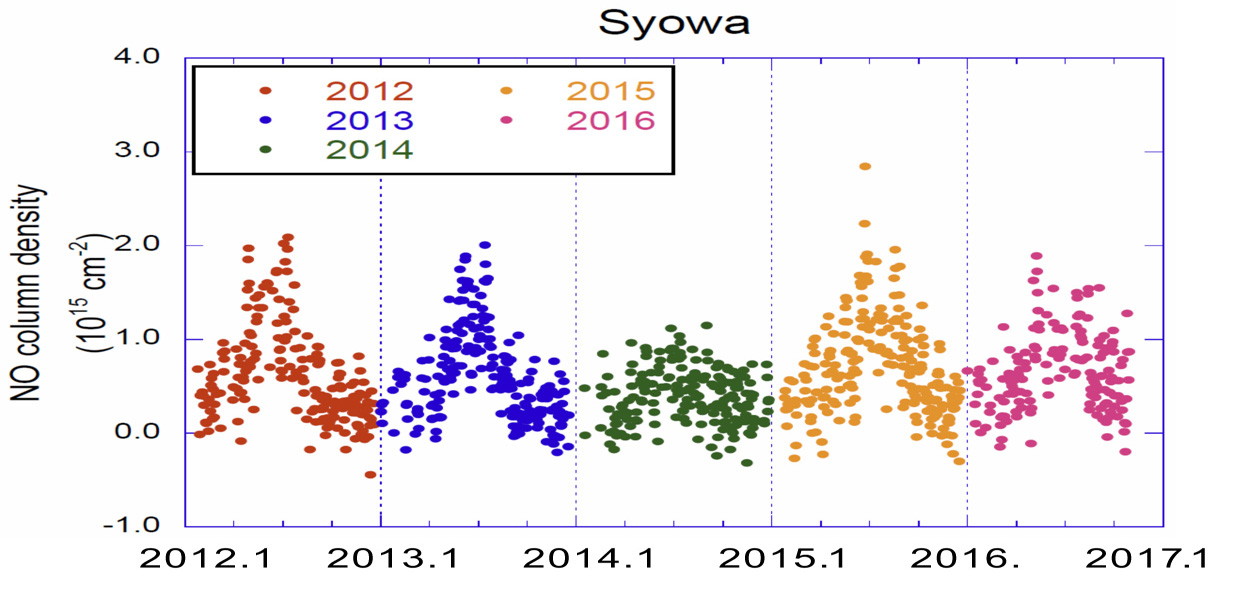
Time series of NO column density from 2012 to 2016.
Millimeter-wave Spectrometer in Tromsoe, Norway for Coordinated Observation with Syowa
@As described above, energetic particle precipitations (EPPs) related to solar activity induce changes of chemical composition around mesosphere and lower thermosphere in the polar regions. Based on the millimeter-wave spectroscopy at Syowa Station since 2012, we revealed so far that NO partial column density in upper mesosphere and lower thermosphere shows two types of temporal variations; one is a seasonal variation increasing in polar winter mainly due to photochemistry, and the other is a short-term (several days) sporadic enhancement related to EPPs. However, during the midnight sun period, the photo-dissociation and EPP induced ionization/dissociation occur simultaneously, and this makes difficult to distinguish and evaluate the pure contribution of the EPP effects on the chemical composition change. Thus, we planned to implement coordinated observations and compare the temporal variations between both polar regions. We installed a new millimeter-wave spectrometer at the EISCAT Tromsoe facility in Norway. The basic feature of the millimeter-wave spectrometer is almost the same as the one operating at Syowa, i.e., equipped with a low-noise superconductive SIS receiver and a digital FFT data processor. Though the instrument is not yet fully operational at present, we succeeded detecting a clear ozone spectrum of S/N ` 12 with 30-second integration as a result of test observation in November 2016. After the second test run in February 2017, we plan to start steady monitoring observations in the middle of 2017.
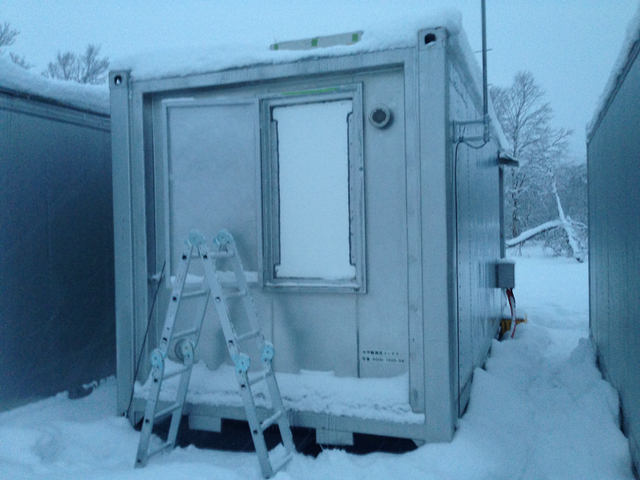
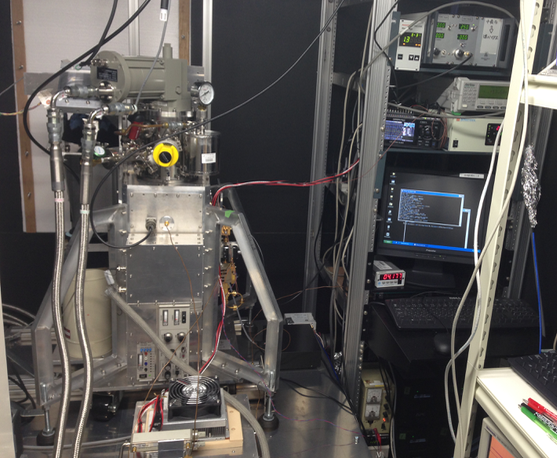
Left: Millimeter-wave observation container at EISCAT in Tromsoe, Norway. Right: Superconductive mm-wave spectrometer system in the container.
Monitoring UV and the vertical distribution of ozone in the middle atmosphere at South America
@Advanced atmospheric observation instruments (i.e., using
millimeter-wave or lasers) are installed in developed countries in the
northern hemisphere. In contrast, the southern hemisphere, especially
the region of South America, is a blank region in the advanced
observation network. The Antarctic ozone hole that appears during the
winter/spring seasons influences the chemical composition of the
stratosphere through dynamical and chemical processes that occur in the
mid-latitude regions of the southern hemisphere, at a time corresponding
to the breakup of the polar spring. The details of these mechanisms
are still unclear, and further observational studies are required. The
ozone hole is an environmental issue that is closely related to the
health of the residents of the southern extremity of South America.
We installed a ground-based millimeter-wave radiometer at Rio Gallegos
(52?S, 69?W, 40 m above sea level) at the Centro de Investigacionese en
L?seres y Aplicaciones (CEILAP) in Argentina, and have been measuring
the vertical distribution of stratospheric ozone since September 2010.
In 2012, our project titled "Project to Develop an Atmospheric
Environmental Risk Management System in South America" was accepted into
the Science and Technology Research Partnership for Sustainable
Development (SATREPS) operated by the Japan Science and Technology
Agency (JST) and the Japan International Cooperation Agency (JICA), and
we have begun collaborative research with the Light Detection and
Ranging (LIDAR) observation group of the National Institute for
Environmental Studies (NIES) in Japan, Argentina, and Chile. The
objectives of the project are: (1) to develop an observation network
for UV, ozone, and aerosols in Patagonia, South America, and (2) to
develop a system for providing information on environmental risk to the
relevant ministries and local residents, based on data from our
observation network.
This year, we extended the basic techniques of observations and data
analysis to local scientists, and the monitoring of ozone commenced.
Although the observations were occasionally stopped due to failures in
the power supply, we have successfully monitored ozone variations from
August to the end of October. As a result, we found a decrease in the
ozone profile caused by the advent of the ozone hole (Fig.). Next year,
we will install an uninterruptible power source to ensure a higher
observation efficiency, and study the vertical structure of ozone in the
middle atmosphere at the border of the ozone hole and the diffusion
process of air parcels with reduced ozone levels to the mid-latitudes.
The observation data for ozone from Rio Gallegos and Atacama in Chile,
and Syowa Station, will be provided to the NIES and placed in
international databases such as Network for the Detection of Atmospheric
Composition Change (NDACC).

Left: Amplification factors [FA = babs(781 nm, 25C) /
babs(781 nm, T), T = 300 and 400 C]. Right: Backward trajectories of
air masses (resolution: 6 h, duration: 72 h) at 1000 m above ground
level over Nagoya. The gray scale of the trajectories indicates the 6-h
average mass absorption cross section for OM that evaporated below 300
C.
Monitoring of stratospheric and mesospheric ozone at Rikubetsu Observatory in Hokkaido
@From the opening of the Rikubetsu Observatory to 2011, the
NIES operated a millimeter-wave radiometer. In 2011 the STEL became
responsible for its operation. Since 2005, when a receiver and a
spectrometer were incorporated for wider bandwidth observations, the
brightness temperatures of observed spectra have tended to be
underestimated by 30|40%. Therefore, we revised the observation system
and made necessary improvements, and reviewed the calibration method of
the observed spectra. For the observation system, the following three
upgrades were performed. (1) The efficiency of the incomplete single
sideband of the receiver was improved using a sideband removal filter
that was developed in collaboration with the Osaka Prefecture
University; as a result the brightness temperature was revised. (2)
Further stability against ambient temperature change was achieved by
replacing an acoustic optical spectrometer with a digital Fourier
transform spectrometer. (3) Automation and remote monitoring were
achieved by changing the control program from MS-DOS to Linux. For the
recalibration of the spectra already acquired, the following correction
methods using the total ozone column from a Brewer spectrometer,
operated by the NIES at Rikubetsu, were developed: (1) Ozone a priori
profile (climatology) was scaled to correspond to the Brewer total ozone
column. (2) A synthetic spectrum was calculated from the scaled ozone
profile according to a radiative transfer theory. (3) To minimize the
difference between the calculated spectrum multiplied by a factor and
the observed spectrum, the factor was determined. (4) The observed
spectrum was divided by the retrieved factor. (5) Finally, ozone
profile retrieval was performed with the original a priori profile.
Taking into account the precision of the total ozone column from the
Brewer spectrometer and the temporal and spatial variability of
atmospheric ozone, the retrieved factors are expected to range around
1.0 } 0.05 (1Π) for the ideal case. However, it was found that the
values are smaller than 1.0 and have large variability. Although the
reason for this is under investigation, we confirmed that when the
receiver was replaced in September 2013 as described above the values
approached 1.0 and depressed the variability.
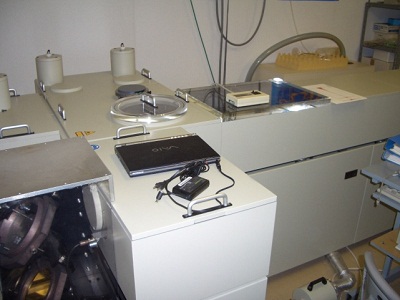
FTIR in Moshiri Observatory.
Monitoring the minor constituents of the stratosphere and troposphere, including greenhouse gases, with infrared spectrometers
@One of the most serious problems in the atmospheric environment is global warming caused by the monotonic increase of greenhouse gases such as carbon dioxide (CO2) in the atmosphere. It is likely that global warming will have a big impact on the Earth's environment and human life-systems in the future. Since 1995, we have continuously measured the absorption spectra of minor constituents of the stratosphere and troposphere, such as ozone and carbon monoxide (CO), using two high-resolution Fourier transform infrared spectrometers (FTIRs) at Moshiri and Rikubetsu observatories. Since 2009, we have been measuring CO2 and methane (CH4) column-averaged mixing ratios (XCO2 and XCH4, respectively). In September 2012, the solar tracker malfunctioned and was brought to Nagoya from Moshiri for repair. It will be reinstalled after next April when observations can resume. We also@installed a compact optical spectrum analyzer for the measurement of CO2 and CH4 absorption lines in the near infrared region in Rikubetsu, and started to measure XCO2 and XCH4 in January 2014. We have continued to improve the light-receiving section of the telescope, which has a 10 mm diameter lens to detect the sunlight absorption spectrum with a high signal-to-noise ratio.
Observation of the planetary atmosphere with radio telescopes in mm and sub-mm wave
@Neptune's stratospheric composition is considered to have
been affected by external sources, such as a previous large cometary
impact. To investigate the extent of such perturbations, we have
performed a systematic survey of the possible remnant species following
the impact. CI chondrites (premodial objects in our solar system),
cometary dust, and ice have a similar elemental abundance ratio. It can
be implied that the elemental abundance observed in the gases produced
after such an impact reflects that found in small bodies in the solar
system. A similar elemental abundance was observed in gases produced by
the collision of comet Shoemaker-Levy 9 with Jupiter in 1994, which was
also similar to the elemental abundance in small bodies in the solar
system. We focused on sulfur-bearing species as remnants of a previous
cometary impact on Neptune, and performed a systematic survey to observe
CS, OCS, SO2, H2CS, C2S, C3S, SO, and H2S using the Atacama
Submillimeter Telescope Experiment (ASTE), which is a 10-m single dish
telescope located in the Atacama highlands, Chile. We detected no
S-bearing species and concluded that Neptune's stratospheric composition
shows a depletion of sulfur. This depletion suggests that S-bearing
species, especially CS, had already been removed from the gas phase by
condensation or polymerization. The exact mechanism is not certain,
while there may also be an unknown CO supply process in addition to the
cometary impact.
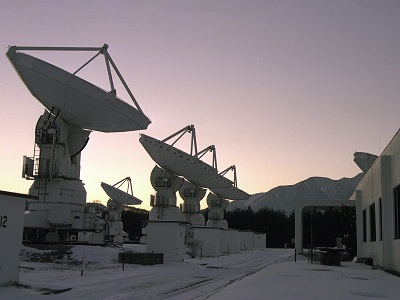
Nobeyama Millimeter Array in Nobeyama Radio Observatory, National Astronomical Observatory.
